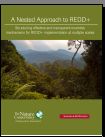Nested REDD+ vital in forest solution: Report
-----------------
In order for REDD+ to be successful in halting deforestation in developing countries, carbon finance incentives will need to be delivered through smaller scale channels as well as big national bureacracies, The Nature Conservancy argues. To this end, the Nature Conservancy has issued a report, ‘A Nested Approach to REDD+’, proposing ways that REDD+ forest carbon projects and programmes at the smaller end of the scale could operate within big national schemes.
REDD+ refers to carbon market mechanisms being devised to pay developing countries and their people to preserve climate-critical forests rather than clear or degrade them.
Much of the practical development of REDD so far has happened at the project level with private sector investment and NGO backing via the voluntary carbon market. There has been concern in these quarters that the evolving direction of UNFCCC policy and US Congress climate bills on REDD might well shut out those that have contributed so much to kick-starting a carbon market around avoiding deforestation.
The Nature Conservancy also questions whether big bureaucratic government schemes can properly deliver the carbon financing benefits to those on the ground who would be the ones changing the land use practices in favour of forest protection; such as forest communities, indigenous groups and small landowners.
The emerging international REDD+ model appears towards one based on agreements between governments where a national forest protection programme in a developing forest country is paid for by a developed country. Carbon credits would be calculated for reductions in the nationwide rate of deforestation against a national baseline and flow from government to government.
The so-called “nested” approach to REDD+ would allow smaller scale activities at a provincial, municipal or individual project level to exist within such big national programmes. The NC report outlines a system where carbon credits or carbon funding could flow directly to sub-national entities or private project developers as well as to national governments based on a dual accounting system that has been “trued up” at the national level.
“In order for REDD+ to be successful, incentives will need to reach the actors responsible for addressing the drivers of deforestation and for shifting land use to a more sustainable and low-carbon model,” the report states. “These actors span multiple scales, from international commodity buyers to national governments to sub-national governments to indigenous peoples and forest‐dependent communities and individual landowners/users. Successful implementation of REDD+ will require motivating all of these actors. Yet to date, much of the focus of policy discussions on REDD+ has been on national governments in developing countries.”
|
---------------


